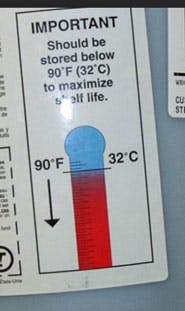Q
“Can you explain the difference between the terms qualitative and quantitative?”
A
Qualitative indicators are not presented as a number (e.g., consider a color change test of a pass/failure). They are indicators that help predict the outcome of a process being monitored. A great example is an indicator you use for steam sterilization.
Quantitative indicators are presented as a number. For example, temperature or humidity monitoring it is a number such as in the decontamination room. You might say it is hot in the room, but it is the number that tells how hot it is. Also, quantitative numbers are often used in your department’s key performance indicator (KPI) process—a quantifiable measure of performance over time for a specific objective. KPIs provide targets/goals for teams to shoot for and help gauge progress into what you are monitoring.
Q
“I have noticed some of my liquid cleaning solution is “separating” when I look at the container. Why is that, and can I still use it?”
A
First, you should be commended for your keen observation skills (noticing something different) when you were handling the cleaning solutions.
We all know temperature plays an important factor in how cleaning solutions work. Each cleaning solution has an “optimum range”.
Liquid cleaning solutions can separate. In my view, it happens more during the shipping/transit process of getting the cleaning solution to your facility. It can also happen if the distribution storage warehouse is not temperature controlled. Sometimes, cleaning solutions sit on the receiving dock for long periods of time in a very hot environment and this could also be a cause. I recommend customers ask how the cleaning solutions are stored and transported to their facility.
Therefore, if you see a splitting or separation of the cleaning solution at any time, contact the OM of the cleaning solution to ask when you can use it (what can you do, if anything, to reconstitute it), and then find out why it happened.
Here are two examples of containers of cleaning solution with a temperature warning (Figs. 1 & 2).
Remember, each cleaning solution has its own limits. You must know the limits to get maximum cleaning power out of them. Storage and transportation also have an impact on how they perform.
Q
“We ran out of sterilization tape, and we were told we could use masking tape. Can I use masking tape?”
A
I have heard of this before with some low-temperature sterilization systems but not with steam.
Here is why you want to use indicator tape for any sterilization process. It is considered by ANSI /AAMI ST79: 2017 to be a “Type 1 (process indicators): chemical indicators intended for use with individual units (e.g., packs, containers) to indicate that the unit has been exposed to the sterilization process and to distinguish between processed and unprocessed units.”1
As per the definition, it is a simple indicator: Your first view if the items have been exposed. If it does not indicate exposure per that specific IFU, then that individual unit (item) is in question.
Concerning masking tape, I have heard of some people using it. I would not. In any case, I would want to know if the items inside the chamber, regardless of the type of sterilization, were exposed.
References:
1. AAMI. (2017). ANSI/AAMI ST79: 2017 Comprehensive guide to steam sterilization and sterility assurance in health care facilities [Section 2.10 chemical indicators (CIs); p 4]. Association for the Advancement of Medical Instrumentation (AAMI).
About the Author

Stephen M. Kovach
Stephen M Kovach, BS, CFER, started in the medical field in 1975 as a sterilization orderly and has worked in many positions within the Healthcare Industry. He presently is Clinical Educator Emeritus at Healthmark, A Getinge company.


